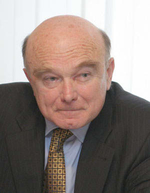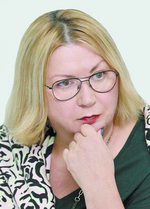Who is “exporting” revolutions to whom?
How Ukraine and Russia will mark the centennial of the October events
In Russia, historical politics has long ceased to be a means of studying and commemorating history itself. Instead, any date or historical person is to be considered exclusively through the prism of the contemporary interests, that is, through the prism of propaganda, geopolitics, and manipulation of public opinion. However, 2017 looks set to become a real challenge for members of the Russian ruling elite who are responsible for this field.
Recently, Vladimir Putin signed a decree on marking “the centennial of the 1917 Revolution in Russia.” The Day’s experts offered comments on things hidden behind such vague wording, as well as the challenges which this anniversary presents to Ukraine.
“IN RUSSIA, THE THEME OF REVOLUTION AND COUNTERREVOLUTION HAS BECOME A TOOL OF PUBLIC OPINION MANAGEMENT”
 Semen NOVOPRUDSKY, independent journalist, Moscow:
Semen NOVOPRUDSKY, independent journalist, Moscow:
“In fact, this instruction reflects primarily two things. Firstly, it is a sacred fear of revolution, which, of course, defines the Russian politics to a large extent. Secondly, it has to do with the preparations for the presidential election. I think that the Administration of the Russian president is aware that for many Russian citizens, some of whom are voters of the Communist Party of the Russian Federation, Liberal Democratic Party of Russia and United Russia, the revolution still remains an important event. And moreover, many of them see it in a positive light.
“In addition, I think that the government can play up the idea of national reconciliation. Let us say, it reflects an attempt to reconcile the Whites and the Reds and consider the history of Russia as a division-free whole. Commemorating the October Revolution enables the government to try and offer an agenda of its own at the official level, through holding certain conferences and making political declarations about honoring all its victims and saying that, on the one hand, it caused many casualties, but on the other, it was fundamentally a good development.
“Had the government refrained from any response, certain political forces would have come forward and said, ‘how do you dare fail to mark such an event’?
“This, incidentally, is quite typical for Putin, as he likes to seize the agenda of any other political force and try to present it as his own.
“In fact, one can hardly say that the Russian government fears a literal repetition of these events. The fact that the theme of revolution and counterrevolution has become a political bargaining chip, a tool of public opinion management in Russia, is another matter.
“It will be interesting to see what rhetoric will be used and what will be done during these events in general. As of yet, there is no clear agenda whatsoever of celebrating the revolution’s centennial. What we can say now is that the government will try to somehow insert the revolution into the country’s contemporary history during these celebrations.”
“THROUGHOUT 1917, THERE WAS ONLY ONE REVOLUTION, AND IT STARTED IN FEBRUARY”
 Stanislav KULCHYTSKYI, Doctor of History, professor, head of the Department of the History of Ukraine in the 1920s-1930s at the Institute of the History of Ukraine:
Stanislav KULCHYTSKYI, Doctor of History, professor, head of the Department of the History of Ukraine in the 1920s-1930s at the Institute of the History of Ukraine:
“I recognize the Russian Revolution which began in February (March according to the Gregorian calendar) and is called the February Revolution, but I do not recognize the Great October Revolution anymore. It was rather a left-wing counterrevolutionary coup. There was a failed right-wing coup attempt, led by Lavr Kornilov, and a successful left-wing coup. Meanwhile, the revolution was one throughout 1917. And it ended in January 1918 with the dispersal of the Constituent Assembly. It is so because the main demand of the revolution in February (or March) 1917 was the overthrow of the autocracy and convocation of the Constituent Assembly, which had to give the people a new government, a new program, and a path of democratic development. Thus we believe. And what does Putin believe? It is very interesting. The wording used in Putin’s order [entitled “Order on Preparation and Conduct of Events Marking the Centennial of the 1917 Revolution in Russia.” – Ed.] is ideologically sterile. Indeed, there was a revolution in 1917. But what kind of revolution was it? The order says nothing on whether it was a bourgeois-democratic, proletarian, popular, February, or an October one.
“We have long had a decree of President Petro Poroshenko on preparations for the 100th anniversary of the Ukrainian Revolution. This Ukrainian Revolution effectively began in March 1917 as well with the formation of the Central Rada, which established the Ukrainian People’s Republic in the course of subsequent developments, which was then suppressed by the Bolsheviks. We will mark precisely that event. But, of course, the Ukrainian Revolution did not occur in a vacuum, but was part of the general Russian Revolution. That revolution’s defining feature was the overthrow of autocracy. We will mark the centennial of the Ukrainian Revolution. I do not know how it will fit what Russia is doing.
“The problem is that the contemporary Putinist Russia treats the Whites and the Reds equally. They make no difference between Anton Denikin and Vladimir Lenin, to speak of the protagonists. This is evident in the Russian state symbols as well, which use the melody of the anthem of the Soviet Union, on the one hand, but on the other, they include the pre-revolutionary tricolor national flag and St. Andrew’s naval flag, also a pre-revolutionary tradition. That is, they use the Soviet national symbols along with, so to speak, anti-Soviet ones. The entirety of contemporary Russian history is built on this ideological pluralism. It is certainly somewhat schizophrenic, but there are pragmatic reasons for it. It is because some Russians are anti-Bolshevik, while others are pro-Bolshevik in their attitudes. And to prevent them from fighting each other, and make them all ‘fight for the modern Russian statehood,’ such ideological pluralism is allowed.”
“WE CAN ASSUME THAT MOSCOW-BASED POLITICAL TECHNOLOGISTS PREPARE A CLASS CONFRONTATION FOR US IN 2017”
 Larysa IVSHYNA, Den/The Day’s editor-in-chief:
Larysa IVSHYNA, Den/The Day’s editor-in-chief:
“They inherited all types of statehood: Moscow is the Third Rome and the heir of Rus’; they describe Ivan the Terrible, and Peter the Great, and Joseph Stalin as good leaders, but living Vladimir is, of course, the best of them. They want to create an image of state continuity, a kind of Thousand-Year Reich, and burden us with all types of the Ruin.
“The only obstacle they meet in implementing this project is Ukraine, which is ‘wandering in broad daylight’ and has not determined for itself what to do with our state. And they think, ‘would not it be a good idea to spark a revolution there again?’ In fact, the October Revolution took place in St. Petersburg, and we were only hit by a ‘shock wave’ it emitted. We can assume that Moscow-based political technologists prepare a class confrontation for us in 2017. That is in addition to our politicians doing a lot for it themselves: they have enacted a ‘budget law’ that spreads mass poverty... And then new Marusia Nikiforovas come forward and incite people against those who have got confused in e-declarations... And then, it can develop as outlined in Dostoevsky’s Demons...
“Therefore, we must be very careful and mature, and spend at least three minutes thinking about the likely consequences before taking a step. Then, I think, we will have a chance to somehow make it through 2017. The coming year, the Year of the APC-Borne Rooster, should be a deterrent image making one recall another rooster, the hospitable one... It is hard not to respond to injustice and political games, but we need self-control now.”
Newspaper output №:
№80, (2016)Section
Day After Day





